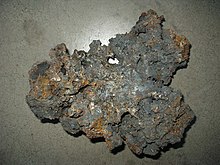Tamahagane
Tamahagane {tah-mah-ha-ga-neh} is a high quality metal (steel) made in the Japanese tradition. The word tama means "round and precious", like a gem or jewel. The word hagane means "steel". On the market, it costs 50 times more than ordinary steel. Tamahagane steel is used to make Japanese swords, knives, and other kinds of tools.

Good tamahagane contains around 1% of carbon and should not go over 1.5%.
Production
changeTamahagane is made of iron sand (called satetsu in Japanese). There are 2 main types of iron sands: akome satetsu and masa satetsu. Akome is of lower quality and masa is of better quality. The man who leads the team at the TATARA is called the murage. Depending on the desired result, the murage mixes one or more types of sands.
The iron sand is put in a clay tub (furnace) called a tatara. The clay tub measures about 4 feet tall, 12 feet long, and 4 feet wide. The tub is then dried and heated. The clay tub is heated to a high temperature, about 1000 ºC (1.832 ºF). Then, it is filled with charcoal and iron sand to start the direct reduction process.
The process of making tamahagane continues for 36 to 72 hours, depending on how many people work and how much metal is to be obtained. The iron sand is added every 10 minutes, alternately with a regular amount of charcoal.
When the liquid slag is drawn out and the process is finished, the clay tub is broken and the KERA (raw iron block) is removed. The best steel with highest carbon content is near the vents of the blower system, because this is the where the reduction process is strongest. The quality of tamahagane is determined by its breaking structure, but it is important to knowe that there are different types of TAMAHAGANE needed to forge a sword blade.